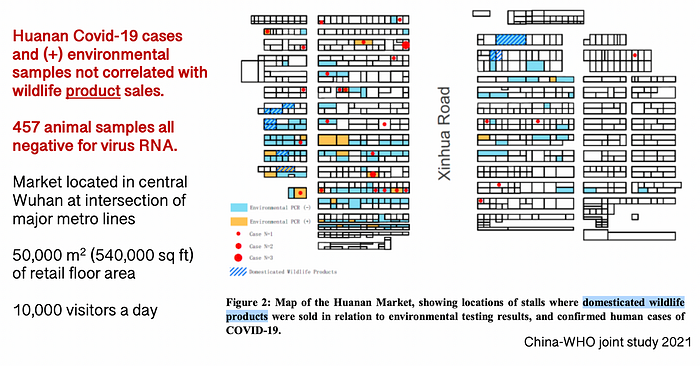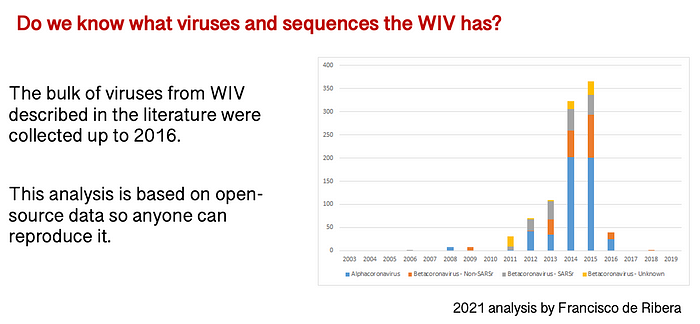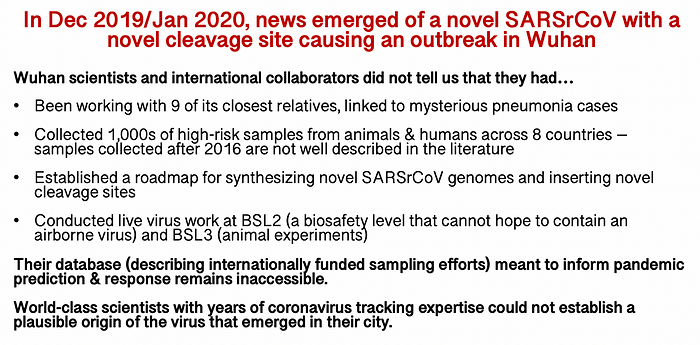The evidence for a natural vs lab origin of Covid-19
By Alina Chan, on social media hiatus, tweets on #OriginOfCovid can be found @ayjchan
Declaration of competing interests: The author of this article has co-authored a book, VIRAL: The Search for the Origin of Covid-19, with science writer Matt Ridley. The updated paperback of VIRAL was published in June 2022 by HarperCollins UK and USA. The book explores both natural and lab Covid-19 origin hypotheses.
For readers looking for a critique of the 2 new studies suggesting a market origin of the pandemic, please see my other medium post: “Evidence for a natural origin of Covid-19 no longer dispositive after scientific peer review”
One commonly asked question is what is the evidence for a natural versus a laboratory origin of Covid-19?
After spending 2 years looking into the available evidence, I have written a book and given a few talks on this topic. The top points are summarized here, with much more detail and backstory available in the paperback of VIRAL: The Search for the Origin of Covid-19.
At the moment, there is still no definitive evidence for any origin scenario. Therefore, experts and investigators (including expert panels convened by the World Health Organization and the Lancet Covid-19 Commission) agree that both natural and lab origin hypotheses remain plausible and must each be rigorously investigated.

What are the plausible scenarios by which the pandemic virus, SARS-CoV-2, might have emerged in Wuhan in 2019? The fact that an ancestral version of the virus must have existed in bats at some point in history is not controversial. The focus of the #OriginOfCovid debate is on how a bat virus, most likely located in Southern China or Southeast Asia, made its way to Wuhan (Central China).
The two main contenders are natural (e.g., exposure of people to infected animals in the wildlife trade or their natural habitats) or research-related (e.g., exposure of a researcher to infected animals or pathogens during fieldwork or in the laboratory). There is some overlap between natural and lab-based scenarios because both can involve people being exposed to novel pathogens in nature during their work, whether it be virus hunting or mining for bat guano.

Early in the pandemic, scientists tried to figure out if they could tell whether there were obvious signs of lab manipulation or genetic engineering. What makes it particularly difficult to distinguish natural viruses from lab-modified/manipulated viruses is that technologies to evolve or engineer viruses in the lab have made such great advances in the years leading up to the pandemic that scientists can seamlessly re-create and alter the genomes of naturally found viruses in a matter of weeks.

The technology to synthesize viruses found in nature and put in any changes you like was demonstrated when the pandemic virus’ genome was released in January 2020:
So, unfortunately, we cannot tell from the virus genome if it emerged naturally or via research activities (fieldwork, lab manipulation, and/or genetic engineering). Other, most likely forensic, evidence is required to understand whether the pandemic virus passed through a field researcher or a laboratory to emerge in Wuhan.
What is the balance of evidence for a natural vs lab origin?



What are the unknowns that make it difficult to put any particular origin hypothesis to rest?
(1) We don’t know who the earliest cases were, just that an early cluster of cases was located at a live animal market in Wuhan (see my other medium post for more details on this). Due to the belief at the time that this was a repeat of the 2003 SARS epidemic, local investigators focused their search for early coronavirus cases solely on the market, nearby hospitals and its neighborhood — this approach would’ve missed other early clusters in other parts of the city considering the mildness of Covid-19 in the general population. Until today, the available evidence does not make clear whether the market was only the site of a human superspreader event or the site of the animal-to-human spillover of the virus.


(2) We don’t know if there were any infected animals at the market or its supply chain (or actually anywhere in China’s wildlife trade). We do know (since the beginning of the pandemic) that animals that could potentially act as the intermediate host of the virus were sold at the market. When investigators went to take samples from the market in January-March 2020, they did not find any live mammals in the market. However, because they believed that the novel coronavirus had come through the wildlife trade, they took most of their samples from stores that had sold wildlife or stores where there were known early human cases. None of the animal samples tested positive for virus. Only some environmental samples (e.g., door handles, floors, walls, sewage, equipment) tested positive for virus. They reported that there was no correlation between the type of product sold and the environmental samples that had tested positive for the novel coronavirus. However, it is essential for the complete market sampling dataset to be released before we can understand whether this claim is true. The preprint from the Chinese CDC that describes this data is still under peer review and I hope that the journal will mandate the release of their full data.





However, we do know that Wuhan was not predicted to be the likely location of a natural spillover of SARS-like viruses from bats into people.



(3) We do not know what viruses had been collected and studied in Wuhan labs, especially in the few year right before the pandemic. The viruses collected by the Wuhan Institute of Virology that are described in the scientific literature were largely collected up to 2016. In the now publicly available research proposals by the Wuhan scientists, they describe ~180–220+ unique SARS-like viruses sequenced — these have not been fully accounted for in international databases. This means that we do not know what new viruses were discovered and worked with in the 3 years leading up to the pandemic. In VIRAL, we go into great detail about the types of experiments that were conducted and how these could have plausibly led to the emergence of the pandemic virus. However, we emphasize that, similar to the market/wildlife trade scenario, definitive evidence is still lacking or being withheld.



Unfortunately, Wuhan scientists and their collaborators in the US have been less than forthcoming on what they know about the viruses studied and types of experiments conducted preceding the pandemic. These concerning information had to be drawn out of them by pulling up obscure academic and medical theses, combing through databases, suing via the Freedom Of Information Act, and leaks from inside the US government. I particularly commend the reporting by the Intercept (see 1, 2, 3, 4).



Disturbingly, documents leaked in September 2021 revealed that Wuhan scientists were part of an international research proposal (from early 2018) that described exactly the type of research that could have created the pandemic virus. Put it this way, it is as if these scientists proposed to put horns on horses and 2 years later a unicorn shows up in their town. When they discover this unicorn and describe it to the public, they talk about every other feature on the creature except for the horn. For a more technical breakdown, see my peer-reviewed analysis here.


This is not to say that it is pointless to investigate the origin of Covid-19 or that we will never know. As with previous outbreaks, there are certainly people who hold key pieces of evidence but are waiting until a safer time to share this with reliable parties — sometimes this can be measured in decades. Furthermore, there are still many routes of investigation, including outside of China, that are very likely to be productive. The problem is that a credible investigation has yet to be conducted, largely due to geopolitics and the fact that some influential scientists have spent the last 2.5 years trying to cast the lab leak hypothesis as a conspiracy theory (early 2020) or so unlikely as to be unworthy of spending resources investigating (mid 2022).
Considering the devastating impact of the pandemic, there are actions we can and should take to safeguard against future outbreaks and to make it easier (and faster) to track the origins of future outbreaks:

For a deeper dive into any of the points summarized here, I recommend getting a copy of my book, VIRAL: The Search for the Origin of Covid-19, co-authored with science writer Matt Ridley. The updated paperback of VIRAL was published in June 2022 by HarperCollins UK and USA.
